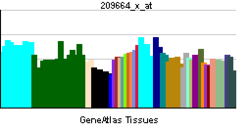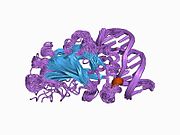- NFATC1
-
Nuclear factor of activated T-cells, cytoplasmic 1 is a protein that in humans is encoded by the NFATC1 gene.[1]
The product of this gene is a component of the nuclear factor of activated T cells DNA-binding transcription complex. This complex consists of at least two components: a preexisting cytosolic component that translocates to the nucleus upon T cell receptor (TCR) stimulation, and an inducible nuclear component. Proteins belonging to this family of transcription factors play a central role in inducible gene transcription during immune response. The product of this gene is an inducible nuclear component. It functions as a major molecular target for the immunosuppressive drugs such as cyclosporin A. Five transcript variants encoding distinct isoforms have been identified for this gene. Different isoforms of this protein may regulate inducible expression of different cytokine genes.[2]
Contents
Interactions
NFATC1 has been shown to interact with PIM1.[3]
See also
References
- ^ Northrop JP, Ho SN, Chen L, Thomas DJ, Timmerman LA, Nolan GP, Admon A, Crabtree GR (Jul 1994). "NF-AT components define a family of transcription factors targeted in T-cell activation". Nature 369 (6480): 497–502. doi:10.1038/369497a0. PMID 8202141.
- ^ "Entrez Gene: NFATC1 nuclear factor of activated T-cells, cytoplasmic, calcineurin-dependent 1". http://www.ncbi.nlm.nih.gov/sites/entrez?Db=gene&Cmd=ShowDetailView&TermToSearch=4772.
- ^ Rainio, Eeva-Marja; Sandholm Jouko, Koskinen Päivi J (Feb. 2002). "Cutting edge: Transcriptional activity of NFATc1 is enhanced by the Pim-1 kinase". J. Immunol. (United States) 168 (4): 1524–7. ISSN 0022-1767. PMID 11823475.
Further reading
- Rao A, Luo C, Hogan PG (1997). "Transcription factors of the NFAT family: regulation and function.". Annu. Rev. Immunol. 15: 707–47. doi:10.1146/annurev.immunol.15.1.707. PMID 9143705.
- Crabtree GR (1999). "Generic signals and specific outcomes: signaling through Ca2+, calcineurin, and NF-AT.". Cell 96 (5): 611–4. doi:10.1016/S0092-8674(00)80571-1. PMID 10089876.
- Horsley V, Pavlath GK (2002). "NFAT: ubiquitous regulator of cell differentiation and adaptation.". J. Cell Biol. 156 (5): 771–4. doi:10.1083/jcb.200111073. PMC 2173310. PMID 11877454. http://www.pubmedcentral.nih.gov/articlerender.fcgi?tool=pmcentrez&artid=2173310.
- Tolstrup M, Ostergaard L, Laursen AL, et al. (2004). "HIV/SIV escape from immune surveillance: focus on Nef.". Curr. HIV Res. 2 (2): 141–51. doi:10.2174/1570162043484924. PMID 15078178.
- Li X, Ho SN, Luna J, et al. (1995). "Cloning and chromosomal localization of the human and murine genes for the T-cell transcription factors NFATc and NFATp.". Cytogenet. Cell Genet. 68 (3-4): 185–91. doi:10.1159/000133910. PMID 7842733.
- Jabado N, Le Deist F, Fisher A, Hivroz C (1994). "Interaction of HIV gp120 and anti-CD4 antibodies with the CD4 molecule on human CD4+ T cells inhibits the binding activity of NF-AT, NF-kappa B and AP-1, three nuclear factors regulating interleukin-2 gene enhancer activity.". Eur. J. Immunol. 24 (11): 2646–52. doi:10.1002/eji.1830241112. PMID 7957556.
- Vacca A, Farina M, Maroder M, et al. (1995). "Human immunodeficiency virus type-1 tat enhances interleukin-2 promoter activity through synergism with phorbol ester and calcium-mediated activation of the NF-AT cis-regulatory motif.". Biochem. Biophys. Res. Commun. 205 (1): 467–74. doi:10.1006/bbrc.1994.2689. PMID 7999066.
- Park J, Takeuchi A, Sharma S (1996). "Characterization of a new isoform of the NFAT (nuclear factor of activated T cells) gene family member NFATc.". J. Biol. Chem. 271 (34): 20914–21. doi:10.1074/jbc.271.34.20914. PMID 8702849.
- Di Somma MM, Majolini MB, Burastero SE, et al. (1996). "Cyclosporin A sensitivity of the HIV-1 long terminal repeat identifies distinct p56lck-dependent pathways activated by CD4 triggering.". Eur. J. Immunol. 26 (9): 2181–8. doi:10.1002/eji.1830260933. PMID 8814265.
- Beals CR, Sheridan CM, Turck CW, et al. (1997). "Nuclear export of NF-ATc enhanced by glycogen synthase kinase-3.". Science 275 (5308): 1930–4. doi:10.1126/science.275.5308.1930. PMID 9072970.
- Kinoshita S, Su L, Amano M, et al. (1997). "The T cell activation factor NF-ATc positively regulates HIV-1 replication and gene expression in T cells.". Immunity 6 (3): 235–44. doi:10.1016/S1074-7613(00)80326-X. PMID 9075924.
- Zhou P, Sun LJ, Dötsch V, et al. (1998). "Solution structure of the core NFATC1/DNA complex.". Cell 92 (5): 687–96. doi:10.1016/S0092-8674(00)81136-8. PMID 9506523.
- Kinoshita S, Chen BK, Kaneshima H, Nolan GP (1998). "Host control of HIV-1 parasitism in T cells by the nuclear factor of activated T cells.". Cell 95 (5): 595–604. doi:10.1016/S0092-8674(00)81630-X. PMID 9845362.
- Chuvpilo S, Zimmer M, Kerstan A, et al. (1999). "Alternative polyadenylation events contribute to the induction of NF-ATc in effector T cells.". Immunity 10 (2): 261–9. doi:10.1016/S1074-7613(00)80026-6. PMID 10072078.
- Chuvpilo S, Avots A, Berberich-Siebelt F, et al. (1999). "Multiple NF-ATc isoforms with individual transcriptional properties are synthesized in T lymphocytes.". J. Immunol. 162 (12): 7294–301. PMID 10358178.
- Wang JK, Kiyokawa E, Verdin E, Trono D (2000). "The Nef protein of HIV-1 associates with rafts and primes T cells for activation.". Proc. Natl. Acad. Sci. U.S.A. 97 (1): 394–9. doi:10.1073/pnas.97.1.394. PMC 26674. PMID 10618429. http://www.pubmedcentral.nih.gov/articlerender.fcgi?tool=pmcentrez&artid=26674.
- Porter CM, Havens MA, Clipstone NA (2000). "Identification of amino acid residues and protein kinases involved in the regulation of NFATc subcellular localization.". J. Biol. Chem. 275 (5): 3543–51. doi:10.1074/jbc.275.5.3543. PMID 10652349.
PDB gallery External links
This article incorporates text from the United States National Library of Medicine, which is in the public domain.
Transcription factors and intracellular receptors (1) Basic domains (1.1) Basic leucine zipper (bZIP)Activating transcription factor (AATF, 1, 2, 3, 4, 5, 6, 7) · AP-1 (c-Fos, FOSB, FOSL1, FOSL2, JDP2, c-Jun, JUNB, JUND) · BACH (1, 2) · BATF · BLZF1 · C/EBP (α, β, γ, δ, ε, ζ) · CREB (1, 3, L1) · CREM · DBP · DDIT3 · GABPA · HLF · MAF (B, F, G, K) · NFE (2, L1, L2, L3) · NFIL3 · NRL · NRF (1, 2, 3) · XBP1(1.2) Basic helix-loop-helix (bHLH)ATOH1 · AhR · AHRR · ARNT · ASCL1 · BHLHB2 · BMAL (ARNTL, ARNTL2) · CLOCK · EPAS1 · FIGLA · HAND (1, 2) · HES (5, 6) · HEY (1, 2, L) · HES1 · HIF (1A, 3A) · ID (1, 2, 3, 4) · LYL1 · MESP2 · MXD4 · MYCL1 · MYCN · Myogenic regulatory factors (MyoD, Myogenin, MYF5, MYF6) · Neurogenins (1, 2, 3) · NeuroD (1, 2) · NPAS (1, 2, 3) · OLIG (1, 2) · Pho4 · Scleraxis · SIM (1, 2) · TAL (1, 2) · Twist · USF1(1.3) bHLH-ZIP(1.4) NF-1(1.5) RF-X(1.6) Basic helix-span-helix (bHSH)(2) Zinc finger DNA-binding domains (2.1) Nuclear receptor (Cys4)subfamily 1 (Thyroid hormone (α, β), CAR, FXR, LXR (α, β), PPAR (α, β/δ, γ), PXR, RAR (α, β, γ), ROR (α, β, γ), Rev-ErbA (α, β), VDR)
subfamily 2 (COUP-TF (I, II), Ear-2, HNF4 (α, γ), PNR, RXR (α, β, γ), Testicular receptor (2, 4), TLX)
subfamily 3 (Steroid hormone (Androgen, Estrogen (α, β), Glucocorticoid, Mineralocorticoid, Progesterone), Estrogen related (α, β, γ))
subfamily 4 NUR (NGFIB, NOR1, NURR1) · subfamily 5 (LRH-1, SF1) · subfamily 6 (GCNF) · subfamily 0 (DAX1, SHP)(2.2) Other Cys4(2.3) Cys2His2General transcription factors (TFIIA, TFIIB, TFIID, TFIIE (1, 2), TFIIF (1, 2), TFIIH (1, 2, 4, 2I, 3A, 3C1, 3C2))
ATBF1 · BCL (6, 11A, 11B) · CTCF · E4F1 · EGR (1, 2, 3, 4) · ERV3 · GFI1 · GLI-Krüppel family (1, 2, 3, REST, S2, YY1) · HIC (1, 2) · HIVEP (1, 2, 3) · IKZF (1, 2, 3) · ILF (2, 3) · KLF (2, 3, 4, 5, 6, 7, 8, 9, 10, 11, 12, 13, 14, 15, 17) · MTF1 · MYT1 · OSR1 · PRDM9 · SALL (1, 2, 3, 4) · SP (1, 2, 4, 7, 8) · TSHZ3 · WT1 · Zbtb7 (7A, 7B) · ZBTB (16, 17, 20, 32, 33, 40) · zinc finger (3, 7, 9, 10, 19, 22, 24, 33B, 34, 35, 41, 43, 44, 51, 74, 143, 146, 148, 165, 202, 217, 219, 238, 239, 259, 267, 268, 281, 295, 300, 318, 330, 346, 350, 365, 366, 384, 423, 451, 452, 471, 593, 638, 644, 649, 655)(2.4) Cys6(2.5) Alternating composition(3) Helix-turn-helix domains (3.1) HomeodomainARX · CDX (1, 2) · CRX · CUTL1 · DBX (1, 2) · DLX (3, 4, 5) · EMX2 · EN (1, 2) · FHL (1, 2, 3) · HESX1 · HHEX · HLX · Homeobox (A1, A2, A3, A4, A5, A7, A9, A10, A11, A13, B1, B2, B3, B4, B5, B6, B7, B8, B9, B13, C4, C5, C6, C8, C9, C10, C11, C12, C13, D1, D3, D4, D8, D9, D10, D11, D12, D13) · HOPX · IRX (1, 2, 3, 4, 5, 6, MKX) · LMX (1A, 1B) · MEIS (1, 2) · MEOX2 · MNX1 · MSX (1, 2) · NANOG · NKX (2-1, 2-2, 2-3, 2-5, 3-1, 3-2, 6-1, 6-2) · NOBOX · PBX (1, 2, 3) · PHF (1, 3, 6, 8, 10, 16, 17, 20, 21A) · PHOX (2A, 2B) · PITX (1, 2, 3) · POU domain (PIT-1, BRN-3: A, B, C, Octamer transcription factor: 1, 2, 3/4, 6, 7, 11) · OTX (1, 2) · PDX1 · SATB2 · SHOX2 · VAX1 · ZEB (1, 2)(3.2) Paired box(3.3) Fork head / winged helix(3.4) Heat Shock Factors(3.5) Tryptophan clusters(3.6) TEA domain(4) β-Scaffold factors with minor groove contacts (4.1) Rel homology region(4.2) STAT(4.3) p53(4.4) MADS box(4.6) TATA binding proteins(4.7) High-mobility group(4.10) Cold-shock domainCSDA, YBX1(4.11) Runt(0) Other transcription factors (0.2) HMGI(Y)(0.3) Pocket domain(0.6) Miscellaneoussee also transcription factor/coregulator deficiencies
B bsyn: dna (repl, cycl, reco, repr) · tscr (fact, tcrg, nucl, rnat, rept, ptts) · tltn (risu, pttl, nexn) · dnab, rnab/runp · stru (domn, 1°, 2°, 3°, 4°)Categories:- Human proteins
- Transcription factors
- Chromosome 18 gene stubs
Wikimedia Foundation. 2010.




